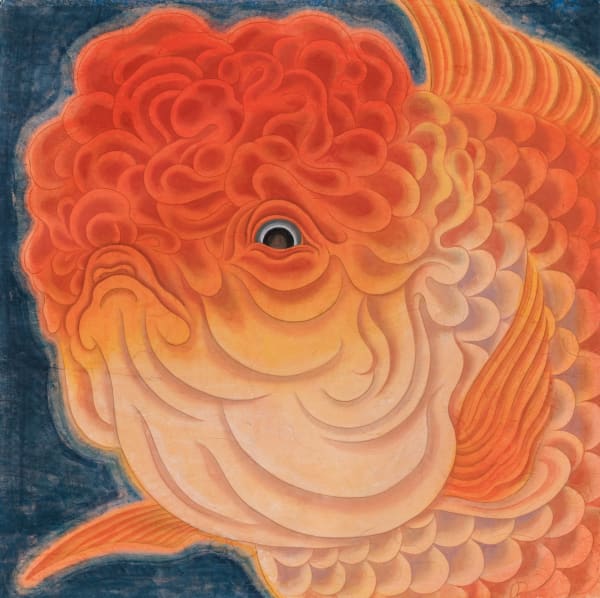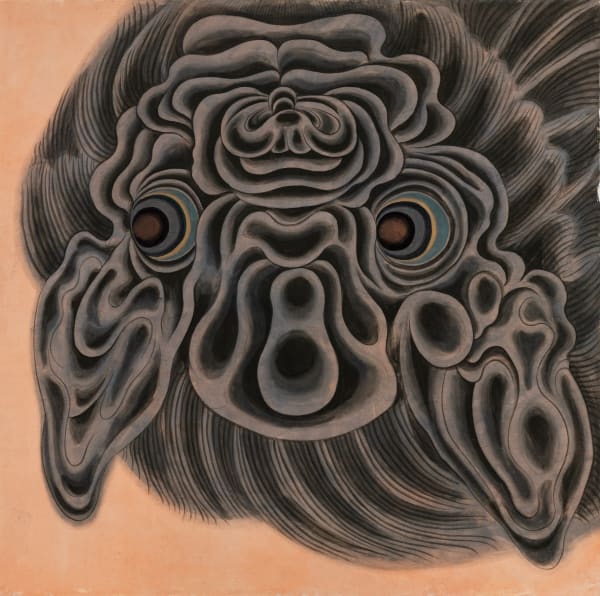Tseng Chien-Ying was born in 1987 in Nantou County, Taiwan and currently works in Taipei. He graduated in 2009 with a BFA from National Taiwan Normal University and in 2013 with an MFA from Taipei National University of the Arts. During his MFA studies, Tseng methodically researched and mastered the materials and methods of jiaocai and Nihonga painting in which mineral pigments such as azurite, malachite, lapis lazuli, lead, cobalt and cinnabar are mixed with animal glue and applied with a fine brush on paper, silk, metal foil or plaster. After graduating, Tseng began to investigate the historical origins of this traditional painting method in East Asian religious and court painting and was awarded an Individual Fellowship by the Asian Cultural Council in 2017 through which he traveled to New York; Yogyakarta, Indonesia; and Northern and Western China where he researched the early Buddhist religious art at the Longmen Grottoes in Luoyang, the Maijishan Grottoes in Tianshui, the Mogao Caves in Dunhuang and the Yungang Caves in Datong.
Central to Tseng’s artistic project is his exploration of religious iconography and religious visual experience in an interrogation of normativity. Using a personally-inflected “queer” sensibility, Tseng inverts or transgresses received notions of normal/abnormal, good/bad, beautiful/ugly, desirable/undesirable using the religious iconography of the sacred and sacrilegious. In his aesthetic rendering of the “queer,” body, artifice, flesh, fetish, sacrifice, bondage, death and decay are made sacred. Tseng’s “queer” sensibility, however, is more than a personal interpretation of post-modern critical theory as his notion of the non-normative draws as well from his investigations of Buddhist philosophy—specifically, the non-reality of dualistic constructions—and Taoism—namely, the radical relativism of thinkers such as Zhuangzi. His artistic project, thus, can be seen as an exploration of how historical Buddhist and Taoist artistic practice and aesthetic experience can be repurposed to give experiential form to our post-modern notion of the non-normative or the “queer.”
Tseng’s interest in religious iconography extends beyond his proximal Asian sources and includes Byzantine icon painting which shares many of the same materials and techniques seen in early Buddhist art. The Buddhist art of Gandhara, which arrives in China in the 3rd Century via the Silk Road is itself an admixture of the religious art of Northern India with classical Greek forms brought to Central Asia by Alexander in the 4rd Century B.C. Because of this, the technical and visual similarities between Byzantine Christian and Central Asian Buddhist art can be striking and Tseng exploits these pre-modern similarities to create a post-modern, trans-national religious iconography—part Christian, part Buddhist, part European, part Asian—in pursuit of a post-modern, trans-national aesthetic of the “queer.”
Tseng Chien-Ying’s artwork has been exhibited at the National Taiwan Museum of Fine Arts, Taichung (2020, 2017, 2015), Kaohsiung Museum of Fine Arts, Kaohsiung (2014, 2009), Taipei National University of Art, Taipei (2013, 2011), and the Tunghai University Art Gallery, Taichung (2011). His works are included in the permanent collections of National Taiwan Normal University, Taipei, Taiwan; the National Taiwan Museum of Fine Arts, Taichung, Taiwan; and the White Rabbit Collection, Sydney, Australia.








